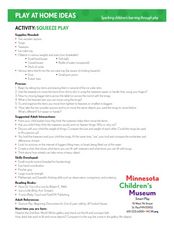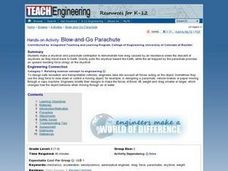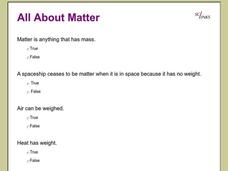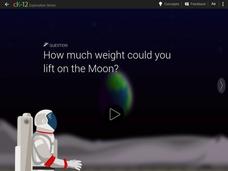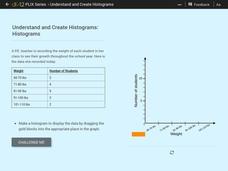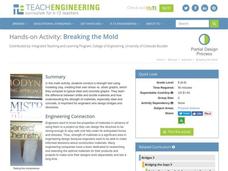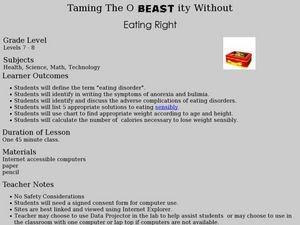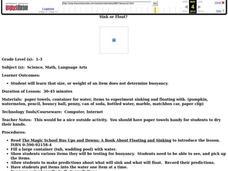Concord Consortium
Gravity
Weight is a function of the distance from sea level. Learners explore the many implications of this fact in an inquiry-based task. Given the function, pupils answer questions before manipulating the function to rewrite the distance...
Computer Science Unplugged
Lightest and Heaviest—Sorting Algorithms
How do computers sort data lists? Using eight unknown weights and a balance scale, groups determine the order of the weights from lightest to heaviest. A second worksheet provides the groups with other methods to order the weights. The...
Education Development Center
Word Problem with Rational Numbers—Balancing Bars of Soap
Here's a resource teachers won't want to wash their hands of. Given a task where a full bar of soap is on one side of a balance and 3/4 of a bar of soup and a 3/4-ounce weight is on the other side, young mathematicians must determine the...
Curated OER
Squeeze Play
Young scientists demonstrate how to move objects. In this fine motor lesson, students use various objects such as dice, erasers, and soft balls and move them using the proper device.
Curated OER
Unit V: Worksheet 2 - Constant Force
Physics learners studying force and acceleration practice solving eight problems with this assignment. They calculate acceleration and deceleration, net force, and distances required for stopping a moving object. Kinematics equations and...
Teach Engineering
Clay Boats
Clay itself sinks, but clay boats float. Why? Young engineers build clay boats to learn about buoyancy. They test the weight the boats can hold using washers and then tweak their designs to make improvements, following the engineering...
Teach Engineering
Physics Tug of War
Slide books with a little assistance from Newton. Using books, groups create a demonstration of Newton's Second Law of motion. Pupils compare the distance traveled by one and two books when they apply a force to them.
Curated OER
Mass Lesson
It's not just a slideshow, it's a lesson on mass. First, learners complete a mental math warm-up, where they determine the number before and after a series of given numbers, then they form groups to weigh packages and compare mass....
101 Questions
The Biggest Loser
Sometimes losing is actually winning! Learners use a proportional analysis to compare percent weight loss of contestants on The Biggest Loser. The resource provides data and clips from the show to facilitate the lesson.
American Chemical Society
The Density of Liquids
It's in your destiny to study density! Young scientists conduct an experiment to study the relationship between weight and density. They compare weights of liquid samples of different substances and predict how their densities are...
Curated OER
Blow-and-Go Parachute
Students design a skydiver and parachute constraption to demonstrate how drag caused by air resistance slows the descent of skydivers as they travel back to Earth. They experience how gravity pulls the skydiver toward the earth and how...
Curated OER
All About Matter
Twenty-four questions about matter, the states of matter and the properties of matter make up this interactive online worksheet. Your class will determine the volume of water, the shape of water and the shapes of matter.
Curated OER
Measurement and Conversion of Units in a Recipe
In a cross-curricular measurement and literacy lesson, your class will identify and compare cooking measurement instruments. They read a recipe and sequence a set of similar instructions in which the steps have been mixed up....
CK-12 Foundation
Astronaut Training Chamber
Most people realize they would weigh less if they were on the moon, but does it change how much weight you could lift if you were on the moon? Scholars adjust the mass of an object to be lifted and select between four different...
CK-12 Foundation
Understand and Create Histograms: Histograms
Determine the shape of weight. Using the interactive, class members build a histogram displaying weight ranges collected in a P.E. class. Scholars describe the shape of the histogram and determine which measure of central tendency to use...
Teach Engineering
Breaking the Mold
A little too much strain could cause a lot of stress. Groups conduct a strength test on clay. Using books as weights, pupils measure the compression of clay columns and calculate the associated strain and stress. Teams record their...
Physics Classroom
Getting a Handle on Torque
Do your young physicists get a little unbalanced when it comes to talking about torque? Scholars examine the effects of weight and distance on a balanced system with a simple interactive from the Rotation and Balance series. The resource...
Physics Classroom
Torque-ing About Rotation
Let's talk torque! Science scholars evaluate experimental setups during an interactive from the Rotation and Balance series. Individuals calculate the torque of differently arranged weights to determine the effect they have on a balanced...
Purdue University
Can You Design and Construct a Better Candy Bag?
Bag the sweet resource for later use! Pupils learn about engineering design by developing a new, improved bag for candy from thin plastic sheets or from paper. The bags are to be visually appealing, but should also be functional. To...
Curated OER
Taming the O-BEAST-ITY Without Eating Right
Young scholars use the Internet to find out about eating disorders and maintaining a healthy weight. In this eating disorders lesson, students identify eating disorders such as anorexia and bulimia and discuss complications. Young...
Curated OER
Youth and weightlifting
Learners research and develop a weight training program appropriate for an 13-16 year old.
Curated OER
Mountain Biking - Riding Uphill
Mountain biking sounds like a lot of fun, but it also sounds like a lot of hard work! You have to get uphill to enjoy the ride downhill. Learn about shifting gears to go uphill and to keep your weight balanced properly. This is one...
Curated OER
Sink or Float?
Young scholars predict and test different items to see if they sink or float. In this sink and float lesson plan, students predict whether an item is buoyant or not, and learn that size and weight do not matter when it comes to buoyancy.
Curated OER
Fractions, Decimals, and Gravity
Students discuss how weight is directly related to gravitational force on a planet. Students then choose Space Traveler as companion and compute how much their guide weighs on various planets, based on each planet's relative surface...
Other popular searches
- Mass and Weight
- Applied Math Weight
- Measuring Weight
- Weight Training
- Algebra 1 Weighted Averages
- Estimate Measure Weight
- Weight Lifting
- Customary Units of Weight
- Weight Measurement
- Weighted Average
- Customary Measurement Weight
- Weight Loss



